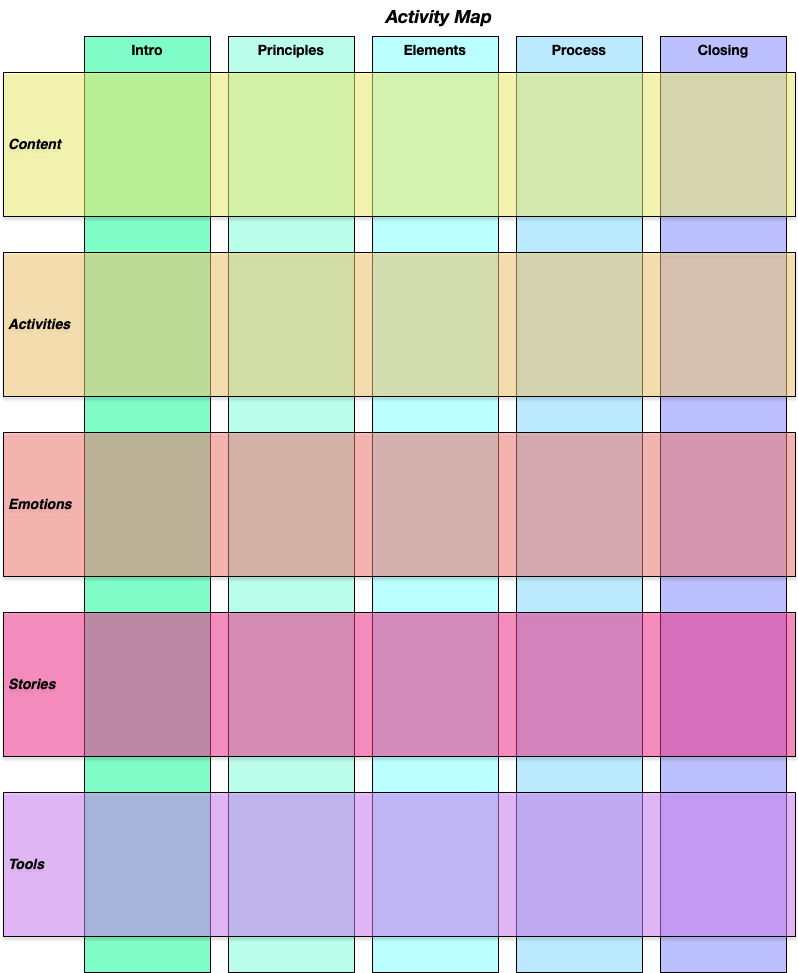I’m working on my next plan for global domination. And as I do, I’ve been developing my thinking, and there are some interesting outcomes. Including a realization that I wasn’t doing what I usually recommend. And I also believe that you should ‘show your work‘. So here I’m practicing the preach.
First, I’m developing my understanding, getting concrete about it. I usually use Omnigraffle as a diagramming tool, to represent my conceptual understandings. And I started doing that as part of the ‘developing thinking’ part. But I started with a diagram, and took the elements out and mindmapped them, and threw in other bits. In short, the ‘diagram’ has become a visual place to store bits and pieces of different diagrams, representations, mindmap, prose, or more. As well as outlining elsewhere. But it’s working out for me, so I thought I’d share.
The overall visualization gives me a place, like a business canvas, to drop stuff on and rearrange. It’s a ‘thinking tool’. I’m also copying part of the the activity map and linking things together to capture the actual flow between content and activities. Etc. A virtual whiteboard, I guess.
Second, one of the things to represent was how this would be communicated. Whether a course, or interactive ebook, or whatever, I want to create a flow. And I realized an activity map might make sense. I haven’t done this before (I’ve used storyboards and diagrams), but I find it interesting. Here’s the current status.
 Across the top are the various stages (Introduction, the Principles, the resulting learning Elements, the associated Process, and the Closing). Your stages may vary. Along the side are the different components (the Content topics, the associated practice Activities, the Emotions I to be evoked, the Stories to tell, and the Tools). I think putting in ’emotion’ is an important step! And then I can drop text bits into the intersections.
Across the top are the various stages (Introduction, the Principles, the resulting learning Elements, the associated Process, and the Closing). Your stages may vary. Along the side are the different components (the Content topics, the associated practice Activities, the Emotions I to be evoked, the Stories to tell, and the Tools). I think putting in ’emotion’ is an important step! And then I can drop text bits into the intersections.
Finally, as I started developing the associated content, I realized one thing I advocate is backwards design. That is, envision the performance and how it’s distributed across tools and brains. Then, I realized I hadn’t designed the tools first! I’m going back and doing that. So it’s now in the activity map as well ;).
Just thought I’d share this, practicing the preach, and hope that you find it interesting, if not useful. Feedback welcome!
Thanks for sharing! I find that when I start from either the front or the back I end up zig-zagging back and forth during my design/conceptualizing phase. And then try to test that deisng and then develop from the end, to the beginning.
Guy, I recall that from HCI research too, teams would switch back and forth from top-down to bottom-up and back. Probably natural.
Clark, thanks for sharing your thought process and tool. I’m always looking to streamline my thinking and design. For me this looks like it can also help identify where your thinking is not complete. So for example, if there is a box that is empty, you would think about it and enter in thoughts/ideas? I am also assuming not all boxes need to have content in them. yes?
Wendi, yes, it’s to prompt consideration of possible components. If there’s an empty box, and you’ve explicitly considered it and it’s ok, then no worries.